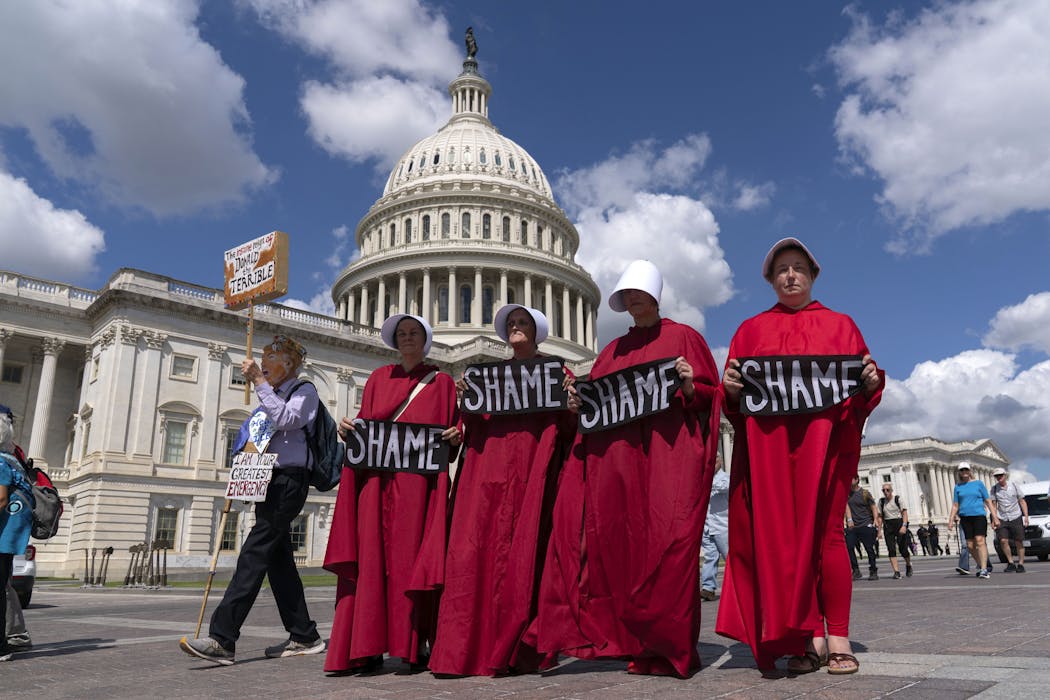Source: The Conversation – USA – By Seda Saluk, Assistant Professor of Women’s and Gender Studies, University of Michigan

Pregnant women crossing borders to get an abortion. People who miscarry facing jail time or dying from infection. Doctors who won’t perform lifesaving procedures on a pregnant patient for fear of prosecution.
For years, this was the kind of thing that happened in Poland, Nicaragua or El Salvador. Now, it’s headline news in the United States.
As a scholar who studies the relationship between reproductive rights and political regimes, I see the U.S. mirroring a pattern that has happened in authoritarian regimes around the world. When a government erects barriers to comprehensive reproductive care, it doesn’t just cause more death and suffering for women and their families. Such policies are often a first step in the gradual decline of democracies.
Yet, the U.S. is different in a meaningful way. Here, abortion has historically been framed as a personal right to privacy. In many other countries I’ve studied, abortion is viewed more as a collective right that is inextricably tied to broader social and economic issues.
The American individualist perspective on abortion can make it harder for people in the U.S. to understand why banning abortion can serve as a back door for the erosion of civil liberties – and of democracy itself.
Autocrats target abortion first
Restricting reproductive rights is a hallmark of authoritarian regimes.
From Benito Mussolini’s Italy in 1926 and Josef Stalin’s Soviet Union in 1936 to Francisco Franco’s Spain in 1941 and Nicolae Ceaușescu’s Romania in 1966, the first move most 20th-century dictators made after seizing power was to criminalize abortion and contraception.
Initially, for some of those autocratic leaders, limiting access to abortion and contraception was a strategy to gain the approval of the nation’s religious leaders. The Catholic Church held great power in Italy and Spain, as did the Orthodox Church in Romania. At the time, these faiths opposed artificial birth control and still believe life begins at conception.
Restrictions on reproductive rights also aimed to increase birth rates following two world wars that had stamped out some of the population, particularly in the Soviet Union and Italy. Many political leaders saw procreation as a national duty. They designated women – white, heterosexual women, that is – specific roles, primarily as mothers, to produce babies as well as future soldiers and workers for their regimes.
In the past two decades, countries in Europe and the Americas have been following this recognizable pattern. Nicaragua and Poland have both banned abortion. Hungary, Turkey and Russia have all clamped down on access to it.
Restricting reproductive freedoms has helped Hungary’s Viktor Orbán, Russia’s Vladimir Putin and Turkey’s Recep Tayyip Erdoğan stoke lasting political divisions within society that help them consolidate their own power.
These leaders invoke a threat of moral and demographic decline, claiming that child-free women, queer people and immigrants pose a danger to national survival. In doing so, they portray themselves as defenders of their respective nations. It’s a way to regain and retain popular support even as their policies deepen poverty, erode civil liberties and increase corruption.
These politicians have also taken power away from a significant portion of the population by reinstating earlier, fascist-era restrictions on bodily autonomy. As feminist scholars have pointed out, strong reproductive rights are central to functioning democracies.
Restrictions on reproductive freedoms often necessitate other kinds of restrictions to enforce and maintain them. These might include free speech limits that prohibit providers from discussing people’s reproductive options. Criminalizing political dissent enables the arrest of people who protest restrictions on reproductive freedoms. Travel bans threaten prison time for individuals who help young people get abortion care out of state.
When these civil liberties weaken, it becomes harder to defend other rights. Without the right to speak, dissent or move freely, people cannot engage in conversations, organize or voice collective grievances.
Putting the US in a global context
In 2022, the U.S. joined the likes of Poland and Hungary when the Supreme Court overturned Roe v. Wade, ending 50 years of federal abortion protections.
President Donald Trump was not in power when this happened. Yet the Supreme Court’s conservative majority was shaped during his first term.
Since then, both the second Trump administration and many states have enacted their own regulations or bans on abortion. This has created a divided country where in some states abortion is as restricted as it is under some of the world’s most autocratic regimes.
Yet, there’s a key difference.
In the U.S., abortion is viewed by the law and the public as a matter of individual rights. The debate often boils down to whether a person should be allowed to terminate their pregnancy.
In many other contexts, reproductive rights are understood as a collective good that benefits all society – or, conversely, harms all society when revoked.
This perspective can be a powerful driver of change. It’s how, for example, women’s and feminist groups in places such as Argentina, Colombia and Mexico have successfully pressured their governments to decriminalize abortion in recent years.
Since 2018, the movement known as Latin America’s Green Wave, or “Marea Verde” for their green protest bandannas, has deliberately and strategically reframed abortion as a human right and used that assertion to expand reproductive rights.
The Latin American feminist activists have also documented how restricting abortion intensifies authoritarianism and worsens both individual and collective rights.
In a region where many citizens remember life under military dictatorship, highlighting the relationship between abortion and authoritarianism may be particularly galvanizing.
Limits of framing abortion as an individual right
Roe v. Wade in 1973 recognized abortion as a private medical decision between “the woman and her responsible physician” up to the point of fetal viability − roughly around 24 to 26 weeks − and that framing has stuck.
This was basically what the mainstream pro-choice movement advocated for at the time. White feminists saw abortion rights as a personal liberty. This framing has real limitations.
As Black and brown reproductive justice advocates have long pointed out, Roe never served women of color or poor people particularly well because of underlying unequal access to health care. Their work has, for decades, illustrated the strong connection between racial, economic and reproductive justice, yet abortion is still largely regarded as solely an individual issue.
When debates about reproductive freedoms are framed as fights over individual rights, it can engender a legal quagmire. Other entities with rights emerge – the fetus, for example, or a potential grandparent – and are pitted against the pregnant person.
Recently, for instance, a pregnant woman declared brain dead in Georgia was kept alive for several months until her fetus became viable, apparently to comply with the state’s strict anti-abortion law. As her mother told the press, her family had no say in the matter.
Narrowly focusing on abortion as an individual right can also obscure why banning it has societal impacts.
Research worldwide shows that restricting reproductive freedoms does not lead to fewer abortions. Abortion bans only make abortion dangerous as people turn to unregulated “back alley” procedures. Maternal and infant mortality rates rise, especially in marginalized communities.
Simply stated: More women and babies die when abortion and contraception laws become more restrictive.
Other kinds of suffering increase, too. Women and their families tend to become poorer when contraception and abortion are hard to get.
Abortion bans also lead to discriminatory practices in health care beyond reproductive health services, such as oncology, neurology and cardiology. Physicians who fear criminalization are forced to withhold or alter gold-standard treatments for pregnant patients, for example, or they may prescribe less effective drugs out of concern about legal consequences should patients later become pregnant.
Lifesaving procedures in the emergency room must await a negative pregnancy test.
As a result, abortion bans decrease the quality and effectiveness of medical care for many patients, not just those who are pregnant.
Defending reproductive freedoms for healthy democracies
These findings demonstrate why reproductive rights are really a collective good. When viewed this way, it illuminates why they are an essential element of democracy.
Already, the rollback of reproductive freedoms in the U.S. has been followed by efforts to limit other key areas of freedoms, including LGBTQ rights, freedom of speech and the right to travel.
Access to safe abortion for pregnant people, gender-affirming care for trans youth, and international travel for noncitizens are intertwined rights – not isolated issues.
When the government starts stripping away any of these rights, I believe it signals serious trouble for democracy.
This story is published in collaboration with Rewire News Group, a nonprofit newsroom dedicated to covering reproductive and sexual health.
![]()
Seda Saluk does not work for, consult, own shares in or receive funding from any company or organization that would benefit from this article, and has disclosed no relevant affiliations beyond their academic appointment.
– ref. Banning abortion is a hallmark of authoritarian regimes – https://theconversation.com/banning-abortion-is-a-hallmark-of-authoritarian-regimes-265459


















